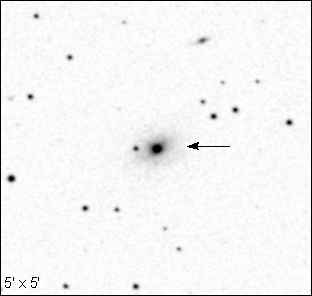
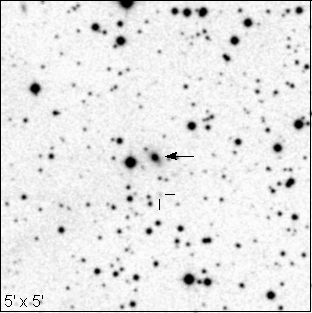
Extragalactic Objects
Discovered As Variable Stars
Wolfgang Steinicke, January 2000
 |
 |
BW Tau and BL Lac - the first two extragalactic variable „stars"
Introduction
Thousends of variable stars were discovered over the past 300 years. The great majority are members of our galaxy. In the 20th century some fascinating objects were found, which turned out to be not stars but extragalactic systems, mostly at cosmological distances: galaxies, quasars or BL Lacertae objects. The recorded brightness variations are then due to violent processes in their kernel regions.
The 21 known cases - discovered, classified and catalogued as variable stars
- are presented here. Most of them (17) are listed in the General Catalogue
of Variable Stars [1]. For each object the history of its discovery
as a "variable star" and the identification with an extragalactic
object, often listed previously as a radio source or galaxy, is discussed. Many
systems were listed as long-period giants, irregular or cataclysmic variables.
Due to their stellar appearence and classification, there was no need or time
for a detailed physical analysis. So they spent their lifes as anonymous entries
in the catalogues, awaiting to get uncovered some day.
In 1968, the first two objects were identified, nearly at the same time. In the 60s astronomers searched intensively for the optical counterparts of radio sources on the Palomar Observatory Sky Survey (POSS). This was possible, when more accurate positions were measured by interferometric methods. In 1965 Arp and Burbidge found, that 3C 120, a radio source detected at Cambridge in 1959, is a Seyfert galaxy at z=0.033. Penston noticed in 1968, that the object is identical with the variable star BW Tau in the constellation Taurus, discovered in 1940 by Hanley and Shapley at Harvard College Observatory. The second case was BL Lac, a variable star in the constellation Lacerta, found by Cuno Hoffmeister in 1929 at Sonneberg. In 1968 Schmitt identified it with the radio source VRO 42.22.01, detected at Vermilion River Observatory in 1965. The next cases were AP Lib and W Com, uncovered in 1971 as remote BL Lacertae objects.
Often it took a long time between discovery and identification. 59 years the variable X Com was known (Wolf 1914), until Bond noticed its extragalactic nature in 1973. Bond was most successful in his search for extragalactic variabel „stars", identifying seven objects, followed by Margon and Deutsch with four objects (Meinunger's „nicht rote" objects). Most of the variables were discovered at Sonneberg (see Hoffmeister's classical book on variable stars [2]) by Meinunger (6), Hoffmeister (5) and Gessner (1).
The largest amplitude of all objects shows W Com, which changes by 6 magnitudes, with a peak magnitude of 11.5 in 1916. AU Leo is an object found to be constant in brightness by Bond. The published variations were due to plate flaws.
The most distant object in the list is the quasar CD Boo at z=1.045, discovered by Meinunger (1972) and identified by Margon and Deutsch (1999). The nearest one is S10838, discovered by Gessner in 1985, which is identical to the galaxy UGC 3374 at z=0.0205. Due to its nonstellar appearence, she suspected an extragalactic nature, which was confirmed in the same year.
There were several cases in which the identification was the result of a systematic search for coincidences between the GCVS and radio source or galaxy catalogues (e.g. AP Lib, V1102 Cyg). Some coincidences were found with negative results, e.g. VX Lib discovered by Shajn 1933, which was found [3] to lie very near to the radio source MSH 15-117. The spectrogram shows the object to be an M star, which is not identical with the radio rource.
Also Bond [4] investigated several objects, which are not known as radio sources, but no new cases came up. So the list presented here marks the present situation, concluding that there might be no more extragalactic objects in the variable star catalogues.
The Objects
The following list (Tab. 1) contains all objects discussed in detail in the main part (pages 1 - 21). The objects are refered by their variable star name. Those objects contained in the GCVS carry a typical designation with letters plus constellation (e.g. IO And) or a V-number (e.g. V395 Her). The Sonneberg objects (S), e.g. S10721 And, do not appear in the GCVS.
Tab. 1 - List of all objects. The last column shows, that the object is listed in catalogues with spectral definition (R = radio, U = ultraviolett, I = infrared, X = Xray).
| No. | Object | Type | Rekt (2000) | Decl (2000) | Brightness | Redshift | Other name | Sp |
| 1 | S10721 And | AGN | 00 38 33.1 | +41 28 50 | 16.9 - 19. | 0.0725 | PGC 2304 | RX |
| 2 | IO And | QSO | 00 48 19.0 | +39 41 09 | 15.3 - 17.6 | 0.134 | S10785 | X |
| 3 | UX Psc | AGN | 01 11 45.4 | +22 04 10 | 13.4 - 16.3 | 0.0456 | NPM1G +21.0054 | |
| 4 | XX Cet | QSO | 02 22 39.9 | -19 32 50 | 18.0 - 19.7 | 0.736 | PHL 4037 | |
| 5 | BW Tau | AGN | 04 33 11.1 | +05 21 14 | 13.7 - 16.4 | 0.033 | 3C 120 | RIUX |
| 6 | S10838 Aur | AGN | 05 54 53.6 | +46 26 22 | 14.4 - 15.5 | 0.0205 | UGC 3374 | RIX |
| 7 | AU Leo | AGN | 11 30 14.4 | +22 48 08 | 17.0 | 0.025 | A 1127+24 | |
| 8 | GQ Com | QSO | 12 04 42.1 | +25 54 12 | 14.7 - 16.1 | 0.165 | PG 1202+281 | X |
| 9 | W Com | BL | 12 21 31.7 | +28 13 58 | 11.5 - 17.5 | 0.102 | ON+231 | RX |
| 10 | X Com | AGN | 13 00 22.5 | +28 24 03 | 12.5 - 17.9 | 0.092 | PGC 44750 | UX |
| 11 | AU CVn | QSO | 13 10 28.6 | +32 20 44 | 14.2 - 20.0 | 0.996 | B2 1308+32 | RIUX |
| 12 | CC Boo | QSO | 13 40 22.8 | +27 40 58 | 17.8 - 19.5 | 0.172 | S10762 | X |
| 13 | CD Boo | QSO | 13 41 23.3 | +27 49 55 | 18.9 - 19.7 | 1.045 | S10763 | |
| 14 | S10764 CVn | QSO | 13 42 10.9 | +28 28 48 | 18.3 - 19.8 | 0.330 | B2 1339+28 | RX |
| 15 | S10765 Boo | AGN | 13 46 47.2 | +29 54 20 | 17.0 - 18.8 | 0.063 | NGP9 F324-276706 | |
| 16 | AP Lib | BL | 15 17 41.9 | -24 22 22 | 14.0 - 16.7 | 0.042 | PKS 1514-04 | R |
| 17 | V395 Her | AGN | 17 22 34.1 | +24 45 00 | 16.1 - 17.7 | 0.0638 | 8 Zw 476 | |
| 18 | V396 Her | QSO | 17 22 41.2 | +24 36 18 | 15.7 - 16.7 | 0.175 | Q1720+246 | RX |
| 19 | V1102 Cyg | AGN | 19 10 37.2 | +52 13 13 | 15.5 - 17. | 0.027 | PGC 62859 | |
| 20 | V362 Vul | AGN | 20 02 48.6 | +22 28 27 | 16.0 - 17.7 | 0.029 | E 2000+223 | X |
| 21 | BL Lac | QSO | 22 02 43.3 | +42 16 39 | 12.4 - 17.2 | 0.069 | VRO 42.22.01 | RI |
Description of the main part
For each object the main designations are given. From these one can see, to which categories it belongs (e.g. galaxy, Xray or radio source). Only the chronologically first and the most commonly used names are presented (in some cases there are more designations, which can be found in the NASA/IPAC Extragalactic Database (NED)). It is not necessary to give e.g. all modern radio source designations, if the object is known as 3C or PKS source. The desginations are listed in Tab. 2, for the abbreviations used see the dictionary of Lortet et al. [5].
All images presented are from POSS II, except the image of XX Ceti, which is from POSS I. The field is 5' x 5' wide, centered on the object (except V1102 Cyg, to include the bright galaxy south).
The J2000 coordinates are measured with RealSky (RS). The B1950 coordinates are taken from GCVS or precessed (p) for non-GCVS objects.The magnitude is photographic (B) in most cases. The size (and the PA) is determined from the POSS image. The type is taken from the literature (Sy1 = Seyfert 1). For the redshift z the most reliable value is given. The distance is the general relativistic „proper motion distance" [6], calculated with H=67 (km/s)/Mpc and q=0.1 (present values). Mmax is the absolute magnitude (at maximum light) as given by Schmidt and Green [7]. The value t means the general relativistic light travel time as given by Sandage [8].
The lines discoverer and nature summarize, who has found the object as a variable star and who has shown the identity with an extragalactic object or has determined the redshift, confirming its nature.
The lines Veron and Hewitt-Burbige show under which designation/type the object is listed in the QSO catalogues of Veron [9] or Hewitt and Burbidge [10]. Additional informations on some objects can be found in Crane's Handbook [11], in the Second Reference Catalogue of Bright Galaxies [12], in Veron's list of radio source identifications [13], in Zwicky's catalogue of compact galaxies [14] or in [15].
The history of the discovery and the major steps of finding the identity of the object is presented, followed by the most relevant references (sorted by year of publification). Historical aspects on quasars or BL Lacertae objetcs can also be found in [16] and [17].
Tab. 2 - List of all designations (followed by object-number, see Tab. 1)
|
10.1916 9 1E 1720+246 18 1ES 0430+052 5 1ES 1202+281 8 1ES 1218+285 9 1ES 1257+286 10 1ES 1308+326 11 1ES 2200+420 21 2A 0551+466 6 II Zw 14 5 3C 120 5 4C+05.20 5 87GB 172040.9+243904 18 8 Zw 476 17 A 0430+05 5 A 1127+24 7 AP Lib 16 AU CVn 11 AU Leo 7 B2 1219+28 9 B2 1308+32 11 B2 1339+28 14 B3 05511+4625 6 BL Lac 21 BW Tau 5 CC Boo 12 |
CD Boo 13 CSO 836 11 DA 140 5 E 2000+223 20 ESO 514-G01 16 FOCA 314 10 GQ Com 8 GR 128 8 HV 10387 5 IO And 2 IRAS 04305+0514 5 IRAS 05511+4625 6 IRAS 13080+3237 11 IRAS 22006+4202 21 MCG 1-12-9 5 MCG 8-11-11 6 Mrk 1506 5 NGP9 F324-276706 15 NPM1G +21.0054 3 NPM1G +24.0247 7 NRAO 182 5 NSV 6399 14 NSV 6440 15 NVSS J003833+412856 1 OF+052 5 ON+231 9 |
OP+313 11 OR-225 16 OY+401 21 PG 1202+281 8 PGC 2304 1 PGC 15504 5 PGC 18078 6 PGC 35442 7 PGC 38224 8 PGC 44750 10 PGC 54592 16 PGC 60156 17 PGC 62859 19 PHL 4037 4 PKS 0430+05 5 PKS 1514-24 16 R 1344.5+3010 15 RX J0038.5+4128 1 RX J0048.3+3941 2 RX J1340.3+2740 12 RX J134211+2828.7 14 S5246 17 S5289 18 S8015 7 S9667 19 S10721 1 |
S10762 12 S10763 13 S10764 14 S10765 15 S10785 2 S10838 6 UGC 3087 5 UGC 3374 6 US 371 11 UX Psc 3 V362 Vul 20 V395 Her 17 V396 Her 18 V1102 Cyg 19 VRO 28.12.02 9 VRO 42.22.01 21 W Com 9 X Com 10 XX Cet 4 ZWG 232.3 6 [CCS88] 133303.9+2380454 13 [GMP83] 2725 10 [HGP92] 133952.8+284355 14 [LBS97] CFHT 19 12 |
References
[1] Khopolov, P.N., et al., General Catalogue of Variable Stars, Nauka Publishing House, Moscow 1988
[2] Hoffmeister, C., Veränderliche Sterne, Johann Ambrosius Barth, Leipzig 1971
[3] Shaffer, D.B., Shields, G.A., ApJ 192, L83 (1974)
[4] Bond, H.E., Tifft, W.G., PASP 86, 981 (1974)
[5] Lortet, M.-C., Borde, S., Ochsenbein, F., The Second Reference Dictionary of the Nomenclature of Celestial Objects, A&AS 107, 193 (1994)
[6] Terell, J., Am. J. Phys. 45, 869 (1977)
[7] Schmidt, M., Green, R.F., ApJ 269, 352 (1983)
[8] Sandage, A., ApJ 134, 916 (1961)
[9] Veron-Cetty, M.-P., Veron, P., A Catalogue of Quasars and Active Galactic Nuclei, ESO Scientific Report No. 18, Garching 1998
[10] Hewitt, A., Burbidge, G., ApJS 63, 1 (1987)
[11] Crane, E.R., A Handbook of Quasistellar and BL Lacertae Objects, Pachart Publishing House, Tucson 1977
[12] de Vaucouleurs, G., de Vaucouleurs, A., Corwin, H.G., Second Reference Catalogue of Bright Galaxies, University of Texas Press, Austin 1976
[13] Veron, M.-P., Veron, P., A&AS 18, 309 (1974)
[14] Zwicky, F., Zwicky, M.A., Catalogue of Selected Compact Galaxies and of Post-Eruptive Galaxies, Zürich 1971
[15] Steinicke, W., Katalog heller Quasare und BL Lacertae Objekte, Freiburg 1984
[16] Burbidge, G., Burbidge, M., Quasi-Stellar Objects, Freeman, San Francisco 1967
[17] Maffei, P., Monsters in the Sky, MIT Press, Cambridge 1980
The Data
|
S10721 And PGC 2304 = RX J0038.5+4128 = NVSS J003833+412856 |
Galaxy in Andromeda | |
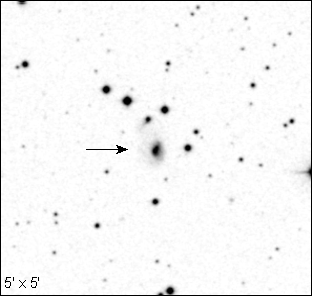 |
(2000.0) (1950.0) Magnitude Size Type z Distance Mmax t Discoverer Nature Veron Hewitt-Burbidge |
00 38 33.1 +41 28 50 (RS) 00 35 49.9 +41 21 21 (p) 16.9 - 19. 24" x 12", 170° Sy1 0.0725 310 Mpc -20.5 0.9 Bill. years Meinunger, Richter 1970 Barbieri, Romano 1976 (galaxy) - - |
The object was discovered in 1970 by Meinunger and Richter as a nebulous variable star on plates taken with the 2m Schmidt telescope at Tautenburg [1]. It was designated Sonneberg variable 10721 (not included in the GCVS) and is located near M 31 and NGC 205. Meinunger saw the possibility of an extragalactic nature of the blue object. Later he suggested that the brightness variation could be explained by a supernova explosion in the nebulous object [2]. He also assumed the object to be identical with the Cambridge radio source 5C3-54.
Barbieri and Romano [3] showed, that the object is a galaxy at z=0.072. They observed irregular variations of large amplitude over short time scales (see also [5]) and found, that it is not identical with the 5C-source. S10721 is a separate source, listed in the 1997 NRAO VLA Sky Survey (NVSS). The modern redshift-value was measured by Osterbrock and Grandi [4], who found the object to be a Seyfert 1 galaxy. Xrays were discovered by ROSAT 1997.
On the POSS image a faint companion (around 18. mag) is seen in 36" at PA 15°. It seems that both objects are connected by a faint bridge.
References
[1] Meinunger, L., Richter, G.A., MVS 5, 139 (1970)
[2] Meinunger, L., IBVS 777 (1973)
[3] Barbieri, C., Romano, G., A&A 50, 15 (1976)
[4] Osterbrock, D.E., Grandi, S.A., ApJ 228, L59 (1979)
[5] Barbieri, C., Cristiani, S., Romano, G., AJ 87, 616 (1982)
|
IO And S10785 = RX J0048.3+3941 |
QSO in Andromeda | |
 |
(2000.0) (1950.0) Magnitude Size Type z Distance Mmax t Discoverer Nature Veron Hewitt-Burbidge |
00 48 19.0 +39 41 09 (RS) 00 48 33 +39 24 52 (GCVS) 15.3 - 17.6 10" Sy1 0.134 561 Mpc -23.5 1.5 Bill. years Meinunger 1975 Borisov 1991(QSO) - - |
The object was discovered in 1975 by Meinunger [1] during a search for variable stars in the field of And (near M 31) with the 40cm Sonneberg astrograph. It was designated Sonneberg variable 10785 and later named IO And in the GCVS. Meinunger saw the possibility of an extragalactic nature of the blue object, similar to BL Lacertae. But he later thought it to be a cataclysmic binary system, comparable with AM Her [2]. He took a spectrum and found no emission lines.
Andronov presented lightcurves, based on nearly 630 plates from the Moscow plate collection, showing a 5-year cyclic variation [3]. Voykhanskava suggested first in 1987, that the object is a quasar (see [4]). This was confirmed by Borisov (IO And, a quasar, not a cataclysmic variable), measuring a large redshift [5]. The modern value (z=0.134) is due to Sharov [6]. ROSAT detected Xray emission of the object (1997). Radio emission is not reported.
References
[1] Meinunger, L., MVS 7, 1 (1975)
[2] Meinunger, L., IBVS 1795 (1980)
[3] Andronov, I.L., IBVS 2429 (1983)
[4] Meinunger, L., Andronov, I.L., IBVS 3081 (1987)
[5] Borisov, A., et al., Astron. Zhura Prisma 17, 563(1991)
[6] Sharov, A.S., AstL 20, 432 (1994)
|
UX Psc NPM1G +21.0054 |
Galaxy in Pisces | |
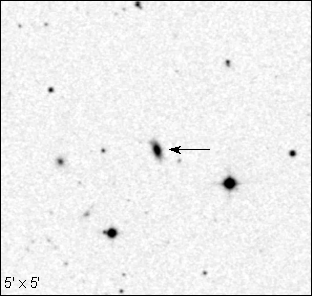 |
(2000.0) (1950.0) Magnitude Size Type z Distance Mmax t Discoverer Nature Veron Hewitt-Burbidge |
01 11 45.4 +22 04 10 (RS) 01 09 08 +21 48 18 (GCVS) 13.4 - 16.3 25" x 12", 15° AGN 0.0456 201 Mpc -23.0 0.6 Bill. years Cragg 1961 Klemola 1983 (galaxy), Osterbruck 1983 (z) - - |
The object was discovered in1961 by Cragg [1] during a routine checking of a new visual sequence for X Psc. He named it C1 Piscium and thought it to be a long-period (300d) red variable with a magnitude change between 13.4 and 15.2. It was later included in the GCVS (1968) as UX Psc. A study of Fix and Weisberg [2] in 1977 with the 300m Arecibo telescope shows no OH emission, typical for long-period (Mira) variables.
In 1983 Klemola [3] considered, that the position of UX Psc lies very near (within 10") to an elongated 16. mag object, probably a galaxy. He was searching for reference galaxies for the Lick proper motion program, so the object appears in the NPM1G catalogue [5]. Klemola found no star at the position and was convinced, that both objects are identical, but he could not determine any variability (see also [4]). The same year Osterbrock (see [3]) measured a redshift of z=0.0456. The object remains since 1986 in the AAVSO chart catalogue of Scovil and Mattei (see: charts.aavso.org/chart01.html). Radio or Xray emissions are not reported.
References
[1] Cragg, T., PASP 73, 453 (1961)
[2] Fix, J.D., Weisberg, J.M., ApJ 220, 836 (1980)
[3] Klemola, A.R., PASP 95, 368 (1983))
[4] Sarcander, M., Sterne u. Weltraum 23, 118 (1984)
[5] Klemola, A.R., et al., AJ 94, 501 (1987)
|
XX Cet PHL 4037 |
QSO in Cetus | |
 |
(2000.0) (1950.0) Magnitude Size Type z Distance Mmax t Discoverer Nature Veron Hewitt-Burbidge |
02 22 39.9 -19 32 50 (RS) 02 20 20 -19 36 18 (GCVS) 18.0 - 19.7 stellar QSO 0.736 2485 Mpc -24.7 5.4 Bill. years Haro, Luyten 1960 Howell, Usher 1993 (QSO, identity) PHL 4037 (QSO) - |
The object was discovered in1960 by Haro and Luyten at Palomar as a „faint blue star" (PHL, see [1]). It was later included in the GCVS as XX Cet. The object was classified for a long time as a cataclysmic variable [4]. Szkody [2] gives a light curve of the object. In 1992 Howell and Usher [3] found, that it is a quasar at z=0.736. Radio or Xray emissions are not reported.
References
[1] Haro, G., Luyten, W.L., Obs. Ton. Bol. 2, N19, 17 (1960)
[2] Szkody, P., et al., PASP 109, 899 (1989)
[3] Howell, S.B., Usher, P., PASP 105, 383 (1993)
[4] Downes, R.A., Shara, N.M., PASP 109, 345 (1997)
|
BW Tau HV 10387 = 3C 120 = II Zw 14 = Mrk 1506 = UGC 3087 = MCG 1-12-9= PGC 15504 = A 0430+05 = PKS 0430+05 = 4C+05.20 = NRAO 182 = DA 140 = OF+052 = IRAS 04305+0514= 1ES 0430+052 |
Galaxy in Taurus | |
 |
(2000.0) (1950.0) Magnitude Size Type z Distance Mmax t Discoverer Nature Veron Hewitt-Burbidge |
04 33 11.1 +05 21 14 (RS) 04 30 32 +05 15 00 (GCVS) 13.7 - 16.4 0.8' x 0.6', 120° Sy1 (S0) 0.0330 145 Mpc -22.0 0.4 Bill. years Hanley and Shapley 1940 Arp 1965 (z), Penston 1968 (identity) 3C 120 (AGN) - |
The object was discovered in 1940 by Hanley and Shapley [1] at Harvard College Observatory. It was named HV 10387 („Harvard variable") and was later included in the GCVS as BW Tau. Until the mid 60s the object appears in different catalogues, but no identity was recognized. In 1959 the Cambridge radio source 3C 120 was detected, but the position was not accurate enough to search for an optical counterpart. In 1964 Vorontsov-Velyaminov and Arhipova included the galaxy MCG 1-12-9 in their catalogue, found by visual inspection of the Palomar sky survey. The same method led Zwicky to the unusual object, published in his second list of compact galaxies in March 1965 (later designated II Zw 14). In the same year the radio source was detected with greater precision at Parkes (PKS 0430+05) and Bolton [2] was able to identify the source, not mentioning 3C 120, with a 15. mag D-galaxy (both results were published in 1966).
Now the story speeds up and it is hard to say, who made which contribution first. The central figures, all in the orbit of Palomar, were „privately" communicating with each other. Arp [3], whose attention to the object was drawn by Bolton, took a photo and a measured a redshift of z=0.033 with the Hale reflector in October 1995. He concludes, that 3C 120 is a Sefert galaxy. Through discussions with Zwicky he was aware, that the object is identical with II Zw 14. Also Margaret Burbidge [4] determined the redshift at that time. The papers were published in June and September 1967 (Arp's paper was late, because it appered in the ordinary ApJ, not in the faster „letters"). Already in March, Kinman [5] and Wills [6] published „letters" on 3C 120. Kinman, analyzing the optical polarization and variability at Lick, mentiones the (unpublished) redshift measurements of Arp and Burbidge. Wills, getting z=0.0325 with the 82cm Struve reflector of the University of Texas, mentioned the identity with II Zw 14. Independently Sargent [7] studies the bright Seyfert galaxy, publishing his results in April 1966. Added in proof he noted, that he has meanwhile noticed Kinman's paper. Than, in February 1968, Penston [8] noticed, that the galaxy 3C 120 = II Zw 14 is identical with BW Tau and that it is also listed in the MCG. Later the object was studied again by Sargent [9] and photometric measurements were given by Pollock [10]. Xray emission was detected by the Einstein satellite and it is listed as an infrared source (IRAS).
References
[1] Hanley, C.M., Shapley, H., Harvard Bull. 913 (1940)
[2] Clarke, M.E., Bolton, J., Shimmins, A.J., Australian J. Phys. 19, 375 (1966)
[3] Arp, H.C., ApJ 152, 1101 (1967)
[4] Burgidge, E.M., ApJ 149, L51 (1967)
[5] Kinman, T.D., ApJ 148, L53 (1967)
[6] Wills, D., ApJ 148, L57 (1967)
[7] Sargent, W.L.W., PASP 79, 369 (1967)
[8] Penston, M.V., IBVS 255 (1968)
[9] Sargent, W.L.W., ApJ 160, 405 (1970)
[10] Pollock, J.T., et al., AJ 84, 1658 (1979)
|
S10838 Aur UGC 3374 = MCG 8-11-11 = ZWG 232.3 = PGC 18078 = B3 05511+4625 = 2A 0551+466 = IRAS 05511+4625 |
Galaxy in Auriga | |
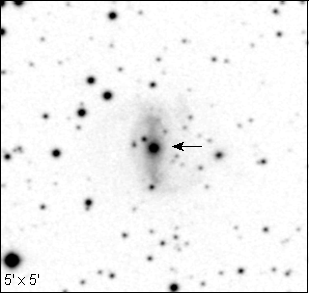 |
(2000.0) (1950.0) Magnitude Size Type z Distance Mmax t Discoverer Nature Veron Hewitt-Burbidge |
05 54 53.6 +46 26 22 (RS) 05 51 09.7 +46 25 51 (p) 14.4 - 15.5 2.1' x 1.5', 90° Sy1 (SB0) 0.0205 91 Mpc -20.3 0.3 Bill. years Gessner 1980 Notni 1980 (identity), Ward (z) - - |
The object was discovered as a nebulous variable star in 1980 by Herta Gessner [1] at Sonneberg. Comparing two 40cm astrograph plates of a field centered at Aur, she noticed the variability. The object was designated Sonneberg variable 10838 (not included in the GCVS). In the same year Notni (see [1]) took a spectrum with the 2m telescope at Tautenburg and found the object to be a Seyfert galaxy (a redshift is not reported). He also noted, that S10838 is identical with MCG 8-11-11, discovered around 1962 by Vorontsov-Velyaminov and Krasnogarskaya on POSS plates.
The redshift of z=0.0205 was published by Ward et al. [2] in 1977. They showed, that the galaxy is the best candidate for the Xray source 2A 0551+466, detected with the Arial V satellite (1976). They noted, that the object is the first Seyfert galaxy to be discovered by its Xray emission (not knowing Notni's results!). In 1997 Bonatto and Pastoriza [3] published a much higher redshift of z=0.0766, which seems unlikely for the extended object. The object was also detected as a radio source (B3) in 1985 and as an infrared source by IRAS.
References
[1] Gessner, H., IBVS 1789 (1980)
[2] Ward, J., et al., A&A 59, L19 (1977)
[3] Bonatto, C.J., Pastoriza, M.G., ApJ 486, 132 (1997)
|
AU Leo S8015 = A 1127+24 = NPM1G +24.0247 = PGC 35442 |
Galaxy in Leo | |
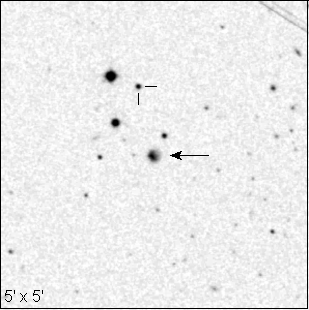 |
(2000.0) (1950.0) Magnitude Size Type z Distance Mmax t Discoverer Nature Veron Hewitt-Burbidge |
11 30 14.4 +23 41 08 (RS) 11 27 37 +24 05 00 (GCVS) 17.0 20" Irregular galaxy 0.0252 99 Mpc -18.1 0.3 Bill. years Hoffmeister 1963 Bond 1974 (identity, z) - - |
The object was discovered in 1963 by Cuno Hoffmeister at Sonneberg [1], named Sonneberg variable 8015 and later included in the GCVS as AU Leo. Comparing the POSS with plates taken with the Sonneberg 40cm astrograph Hoffmeister noticed, that the blue object appears 2 mag brighter on the POSS (estimating 15. mag), leading him to suggest an U Gem-type outburst in 1955. Later Meinunger and Wenzel [2] recorded a brightening on Sonneberg plates exposed in 1932.
In 1974 Bond [3] found the object to be nonstellar on the POSS, which was supported by a visual inspection with the television system at the 5m Palomar reflector by Sargent, seeing a patchy irregular galaxy. The spectrum shows a redshift of z=0.025, confirming the extragalactic nature. Bond surmised, that Hoffmeister might have noticed the unusual appearance while inspecting the POSS and comparing S8015 with S8016=CP Leo, which is only 90" away (marked by bars). Bond was sure, that the object appears brighter on the POSS plate due to its nonstellar image and not by variability. He states, that AU Leo should be considered constant in brightness. This was accepted later by Meinunger [4], admitting that the 1932 outburst was only a plate defect.
The object is included as anonymous galaxy (A) in the Second Reference Catalogue of Bright Galaxies (RC2) and in the Lick Proper Motion Galaxy Catalogue (NPM1G). In 1993 it was still listed as a cataclysmic variable [5]. The object is not known to be a radio or Xray source.
References
[1] Hoffmeister, C., MVS 2, 39 (1963); AN 288, 49 (1964)
[2] Meinunger, L., Wenzel, W., Veröff. Sternw. Sonneberg 7, 389 (1968)
[3] Bond, H.E., Green, R.F., Huchra, J.P., PASP 86, 668 (1974)
[4] Meinunger, L., MVS 7, 42 (1975)
[5] Downes, R.A., Shara, M.M., PASP 109, 127 (1993)
|
GQ Com GR 128 = PGC 38224 = PG 1202+281 = 1ES 1202+281 |
QSO in Coma Berenices | |
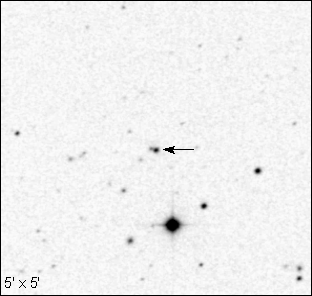 |
(2000.0) (1950.0) Magnitude Size Type z Distance Mmax t Discoverer Nature Veron Hewitt-Burbidge |
12 04 42.1 +25 54 12 (RS) 12 02 09 +28 10 54 (GCVS) 14.7 - 16.1 18" Sy1 0.165 681 Mpc -24.6 1.8 Bill. years Romano 1967 Bond 1977 (QSO) GQ Comae (QSO) 1202+281 |
The object was first mentioned by Romano (1967), who named it GR 128 (GR = G. Romano), later it was included in the GCVS as GQ Com. Observations of its irregular variability, determined at Asiago Observatory, were published in 1973 by Pinto and Romano [1], who gave an incorrect position (corrected by Bond). Light curves of the „variable star" were also published by Hoffleit [2].
In 1977 Bond et al. [3], searching for extragalactic object in the GCVS with spectrographic methods, found GQ Com (together with V396 Her) to be a quasar at z=0.165. Stoughton [4] suggested an extremely faint galaxy contribution east to the quasar (seen on the POSS image). Xrays were discovered in 1979 with the Einstein satellite [5]. GQ Com is also included in the Palomar-Green (PG) blue star survey. Radio emission is not reported.
References
[1] Pinto, G., Romano G., Mem. Soc. Astron. Ital. 44, 53 (1973)
[2] Hoffleit, D., IBVS 1063 (1975)
[3] Bond, H.E., Kron, R.G., Spinrad, H., ApJ 213, 1 (1977)
[4] Stoughton, R.O., PASP 92, 117 (1980)
[5] Tananbaum, H., et al., ApJ 234, L9 (1979)
|
W Com 10.1916 = ON+231 = B2 1219+28 = VRO 28.12.02 = 1ES 1218+285 |
BL Lac in Coma Berenices | |
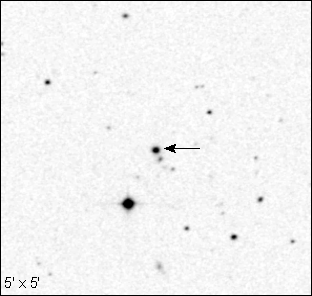 |
(2000.0) (1950.0) Magnitude Size Type z Distance Mmax t Discoverer Nature Veron Hewitt-Burbidge |
12 21 31.7 +28 13 58 (RS) 12 19 01 +28 30 36 (GCVS) 11.5 - 17.5 18" BL Lac 0.102 433 Mpc -26.7 1.2 Bill. years Wolf 1916 Biraud, Browne 1971 (identity), Strittmatter (BL Lac), Weistorp (z) ON 231 (BL Lac) 1219+285 |
The object was discovered in 1916 by Max Wolf at Königstuhl Observatory, who named it 10.1916 [1], later it was included in the GCVS as W Com. Wolf recognized phases of extreme brightness (up to 11.5 mag in 1916) on plates taken with the Bruce-Astrograph. The variability of W Com has been also reported by Hoffleit [5]. On March, 30 1998 it gets brighter than 13. mag (see e.g. the observations of the British amateur Gary Poyner at members.aol.com/GaryPoyner). A light curve was also published by Pollock et al. [6].
The credit of identifing W Com with the Ohio radio source ON+231, detected in 1967, goes to Browne [2] and Biraud [3]. Both reported the case independently and nearly at the same time in mid 1971. Using an interfero-metric radio position, Browne was able to identify the optical counterpart of ON+231 as a 14.5 mag star on the POSS. According to him the identity with W Com was pointed out by Pagels. Biraud used a different approach in searching for coincidences between selected GCVS stars (type given as irregular or unkown) and catalogues of radio sources (e.g. Dixon's Master List of Radio Sources). Two cases, which look very similar, were found: W Com = ON+231 and AP Lib = PKS 1514-24 (see AP Lib). Browne and Biraud reported a 18. mag galaxy-like object (or jet) 12" southwest of the stellar image (see POSS image above). Browne suspected W Com to be a quasar and the companion as a foreground galaxy.
According to its featureless spectrum and other criteria, like synchrotron emission, W Com belongs to the quasarlike class of BL Lacertae objects [4] (see also references for BL Lac). The redshift of z=0.102, which confirms its extragalactic nature, was determined in 1982 by Donna Weistorp with the 4m telescope at Kitt Peak [7]. Xrays were detected with the Einstein satellite (1992). Variable gamma-ray emission was observed in 1998 with BeppoSax.
References
[1] Wolf, M., AN 202 415 (1916)
[2] Browne, I.W.A., Nature 231 515 (1971)
[3] Biraud, F., Nature 232, 178 (1971)
[4] Strittmatter, P.A., et al., ApJ 178, L7 (1972)
[5] Hoffleit, D., IBVS 800 (1973)
[6] Pollock, J.T., et al., AJ 84, 1658 (1979)
[7] Weistorp, D., et al., ApJ 292, 614 (1985)
|
X Com PGC 44750 = FOCA 314 = [GMP83] 2725 = 1ES 1257+286 |
AGN in Coma Berenices | |
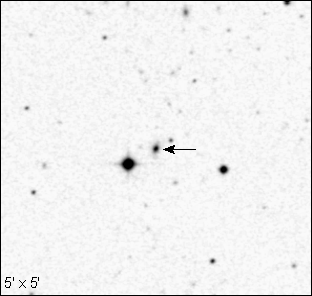 |
(2000.0) (1950.0) Magnitude Size Type z Distance Mmax t Discoverer Nature Veron Hewitt-Burbidge |
13 00 22.5 +28 24 03 (RS) 12 57 03 +28 40 12 (GCVS) 12.5 - 17.9 20"' x 12", 120° Sy1 0.0909 347 Mpc -25.4 1.1 Bill. years Wolf 1914 Bond, Sargent 1973 (galaxy, identity) X COMAE (AGN) 1257+286 |
The object was discovered in 1914 by Max Wolf [1] at Königstuhl Observatory. It is located at the northern edge of the Coma cluster (Abell 1656). On eight plates taken with the Bruce-Astrograph Wolf noticed brigthness variations between 12.5 (in 1911) and 16. Later the object was fainter than 16.5, as it was not found by Perova examining Moscow observatory plates in 1957. Most of the time it remains near 17.5, showing short phases of extreme brightness (see [3]).
In 1973 Bond [2], searching for extragalactic objects in the GCVS, investigated two cases: V1102 Cyg and X Com. Using Perova's finding chart, he found X Com to show a slightly elongated, non-stellar image on the POSS. He suggested, that it is an N-galaxy in the background of Abell 1656. This was confirmed spectrographic observations in the same year [3], which led to a redshift of z=0.092. The modern value was published by Osterbruck and Grandi [4] in 1979. Hewitt and Burbidge list the object as QSO. Being not a member of Abell 1656, the galaxy is included in the cluster surveys of Godwin et al. (GMP83, see [5]) and Donas et al. (FOCA, see [6]), listing the galaxy as a source of UV emission. Xrays were detected with the Einstein satellite in 1992. X Com is not known as a radio source.
References
[1] Wolf, M., AN 198 371 (1914)
[2] Bond, H.E., ApJ 181, L23 (1973)
[3] Bond, H.E., Sargent, W.L.W., ApJ 185, L109 (1973)
[4] Osterbrock, D.E., Grandi, S.A., ApJ 228, L59 (1979)
[5] Godwin, J.G., et al., MNRAS 202, 113 (1983)
[6] Donas, J., et al., A&A 303, 661 (1995)
|
AU CVn US 371 = CSO 836 = OP+313 = B2 1308+32 = 1ES 1308+326 = IRAS 13080+3237 |
QSO in Canes Venatici | |
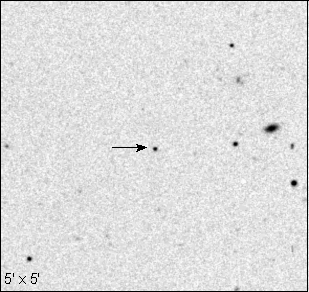 |
(2000.0) (1950.0) Magnitude Size Type z Distance Mmax t Discoverer Nature Veron Hewitt-Burbidge |
13 10 28.6 +32 20 44 (RS) 13 08 08 +32 36 54 (GCVS) 14.2 - 20.0 stellar QSO 0.996 3147 Mpc -29.2 6.3 Bill. years Kurochkin 1960 Miller 1978 (z), Khopolov 1984 (identity) B2 1308+32 (QSO) 1308+326 |
The object was discovered in 1960 by Kurochkin [1]. A light curve was published by Pollock et al. [4]. The object appears in 1968 in the Ohio radio source catalogue as OP+313 and was also detected at Bolgona, designated B2 1308+32. This source was optically identified by Grueff and Vigotti [2] with a stellar object. The redshift was determined in 1978 by Miller et al. [3]. Usher discovered it as an UV excess object in his 1981 sweep of Selected Area 57 [5]. The object is also listed in the1983 Case University survey of stellar emission line objects.
The identity with AU CVn was noted by Khopolov in the 1984 edition of the GCVS. A long time it was thought to be a BL Lac object until Gabuzda 1992 [6] found strong evidence, that it is actually a quasar with unusually weak emission lines. Stickel et al. [7] pointed out, that, in addition to two large and bright galaxies 4' west (an interacting system and an apparently undisturbed elliptical galaxy), the object is surrounded by a large number of faint galaxies (> 20. mag). The Einstein satellite detected Xray emission (1992) and it is also an infrared source, detected by IRAS.
References
[1] Kurochkin, N.E., Perem. Zvezdy 12, 409 (1960)
[2] Grueff, G., Vigotti, M., A&AS 6, 1 (1972)
[3] Miller, J.S., et al., in: Pittsburgh Conference on BL Lacertae Objects, p. 176 (1978)
[4] Pollock, J.T., et al., AJ 84, 1658 (1979)
[5] Usher, P., ApJS 46, 117 (1981)
[6] Gabuzda, D.C., et al., ApJ 410, 39 (1993)
[7] Stickel, M., et al., AAS 98, 393 (1993)
|
CC Boo S10762 = [LBS97] CFHT 19 = RX J1340.3+2740 |
QSO in Bootes | |
 |
(2000.0) (1950.0) Magnitude Size Type z Distance Mmax t Discoverer Nature Veron Hewitt-Burbidge |
13 40 22.8 +27 40 58 (RS) 13 38 04 +27 55 00 (GCVS) 17.8 - 19.5 stellar Sy2 0.172 707 Mpc -21.6 1.9 Bill. years Meinunger 1972 Lamer 1997 (QSO), Jura, Margon, Deutsch 1997 (identity) CC Bootis (AGN) - |
The object was discovered in 1972 by Meinunger with the 2m Schmidt telescope at Tautenburg [1], searching for variable stars in the field of the globular cluster M 3. The 18. mag object shows a variability of 1.5 mag on plates taken between 1964 and 1972. It was first designated Sonneberg variable 10762, named CC Boo in 1975 and included in the GCVS in 1985. Together with S10762, Meinunger found 4 slowly variable objects, stating that they do not belong to the class of red giants in M 3. The others (all included here as extragalactic objects) are S10763 (CD Boo), S10764 and S10765.
In 1992 Jura and Kleinman [2] described the object as a variable halo-supergiant. In 1997 ROSAT found Xray emission at the position and Jura (1997) first noticed the proximity to CC Boo. In the same year Lamer et al. (LBS97, see [3]) identified a quasar at the position, measuring a redshift of z=0.172 with the CFHT. They did not mention the identity with CC Boo. In 1997 Margon [4] published the identity (QSO, not variable halo giant). Radio emission is not reported.
References
[1] Meinunger, L., MVS 6, 37 (1972); AN 294, 251 (1973)
[2] Jura, M., Kleinmann, S.G., ApJS 83, 329 (1992)
[3] Lamer, G., Brunner, H., Straubert, R., A&A 327, 467 (1997)
[4] Margon, B., Deutsch, E.W., PASP 109, 673 (1997)
[5] Margon, B., Deutsch, E.W., PASP 111, 45 (1999)
|
CD Boo S10763 = [CCS88] 133303.9+2380454 |
QSO in Bootes | |
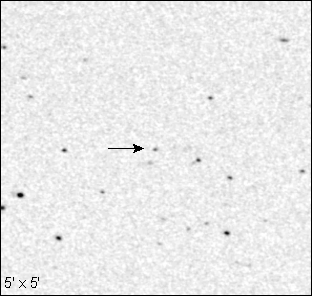 |
(2000.0) (1950.0) Magnitude Size Type z Distance Mmax t Discoverer Nature Veron Hewitt-Burbidge |
13 41 23.3 +27 49 55 (RS) 13 39 06 +28 05 00 (GCVS) 18.9 - 19.7 stellar QSO 1.045 3264 Mpc -24.6 6.4 Bill. years Meinunger 1972 Crampton 1989 (QSO), Margon, Deutsch 1999 (identity) - - |
The object was discovered in 1972 by Meinunger with the 2m Schmidt telescope at Tautenburg [1], searching for variable stars in the field of the globular cluster M 3 (see CC Boo). He remarked, that the object does not belong to class of red giants in M 3. It was designated Sonneberg variable 10763 and named later CD Boo in the GCVS.
Crampton et al. (CCS88, see [2]) found a quasar candidate at the position, later confirming its nature by measuring a high redshift of z=1.045 [3]. They did not mention the identity with CD Boo. Vice versa the object still remains in the literature as a variable supergiant [4]. The identity was finally shown by Margon [5] in his 1999 paper, titled The Meinunger ‚Nicht Rote' Objects. Radio or Xray emissions are not reported.
References
[1] Meinunger, L., MVS 6, 37 (1972); AN 294, 251 (1973)
[2] Crampton, D.C., et al., AJ 96, 816 (1988)
[3] Crampton, D.C., et al., ApJ 345, 59 (1989)
[4] Jura, M., Kleinmann, S.G., ApJS 83, 329 (1992)
[5] Margon, B., Deutsch, E.W., PASP 111, 45 (1999)
|
S10764 CVn NSV 6399 = B2 1339+28 = RX J134211+2828.7 = [HGP92] 133952.8+284355 |
QSO in Canes Venatici | |
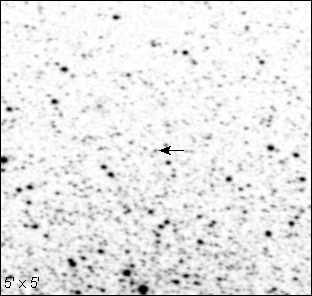 |
(2000.0) (1950.0) Magnitude Size Type z Distance Mmax t Discoverer Nature Veron Hewitt-Burbidge |
13 42 10.9 +28 28 48 (RS) 13 39 52.8 +28 43 54 (p) 18.3 - 19.8 stellar QSO 0.330 1271 Mpc -22.5 3.2 Bill. years Meinunger 1972 Carney 1976 (B2), Harris 1992 (QSO), Margon, Deutsch 1999 (identity) Q1339+2843 (QSO) - |
The object was discovered in 1972 by Meinunger with the 2m Schmidt telescope at Tautenburg [1], searching for variable stars in the field of the globular cluster M 3 (see CC Boo). Meinunger remarked, that the object does not belong to class of red giants in M 3 (lying just at the northern edge). It was designated as Sonneberg Variable 10764 (not included in the GCVS; NSV means a „new suspected variable" by Khopolov 1982).
The object appears in the Second Bologna Catalogue of radio sources (B2), detected in 1970. Carney [2] discovered the optical counterpart in 1976 on a Palomar 5m plate, suggesting a quasar. In 1978 Klemola [3] assigned another (wrong) object as the source. Harris et al. (HGP92, see [4]), searching for QSOs behind globular clusters, confirmed Carney's object as a quasar at z=0.330. Xray emission was detected by ROSAT in 1997. At that time nobody noticed the identity with S10764. This was first shown by Margon [5] in his 1999 paper, titled The Meinunger ‚Nicht Rote' Objects.
References
[1] Meinunger, L., IBVS 738 (1972); MVS 6, 37 (1972)
[2] Carney, B.W., PASP 88, 334 (1976)
[3] Klemola, A.R., PASP 91, 27 (1979)
[4] Harris, H.C., et al., AJ 104, 52 (1992)
[5] Margon, B., Deutsch, E.W., PASP 111, 45 (1999)
|
S10765 Boo NSV 6440 = NGP9 F324-276706 = R1344.5+3010 |
Galaxy in Bootes | |
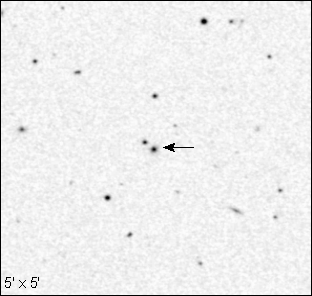 |
(2000.0) (1950.0) Magnitude Size Type z Distance Mmax t Discoverer Nature Veron Hewitt-Burbidge |
13 46 47.2 +29 54 20 (RS) 13 44 30.7 +30 09 17 (p) 17.0 - 18.8 10" E 0.063 273 Mpc -20.1 0.8 Bill. years Meinunger 1972 Odewahn, Aldering 1995 (galaxy), Margon, Deutsch 1999 (identity) - - |
The object was discovered in 1972 by Meinunger with the 2m Schmidt telescope at Tautenburg [1], searching for variable stars in the field of the globular cluster M 3 (see CC Boo). It was designated Sonneberg variable 10765 (not included in the GCVS; NSV means a „new suspected variable" by Kukarkin 1982). Meinunger remarked, that the object does not belong to class of red giants in M 3. He suggested that the brightness variations could be explained by a supernova explosion in the nebulous object, this implies, that he considered an extragalactic nature [2]. The object is included as R 1344.5+3010 in the "Tautenburg Katalog" of 745 compact galaxies in the field of M3 by richter & Richter [3]. The variability is shown in [4].
The object appears in the North Galactic Pole (NGP9) galaxy survey [5]. The redshift and identity with S10765 was published by Margon [6] in his 1999 paper, titled The Meinunger ‚Nicht Rote' Objects. Radio or Xray emissions were not reported.
References
[1] Meinunger, L., MVS 6, 37 (1972)
[2] Meinunger, L., IBVS 777 (1973)
[3] Richter, L., Richter, N., Mitteil. Karl-Schwarzschild-Obs., 80 (1977)
[4] Richter, N., Die Sterne, 56, 341 (1980)
[5] Odewahn, S.C., Aldering, G., AJ 110, 2009 (1995)
[6] Margon, B., Deutsch, E. W., PASP 111, 45 (1999)
|
AP Lib PKS 1514-24 = OR-225 = ESO 514-G01 = PGC 54592 |
BL Lac in Libra | |
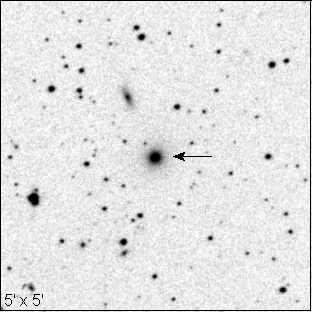 |
(2000.0) (1950.0) Magnitude Size Type z Distance Mmax t Discoverer Nature Veron Hewitt-Burbidge |
15 17 41.9 -24 22 22 (RS) 15 14 45 -24 11 24 (GCVS) 14.0 - 16.7 25" BL Lac 0.0486 189 Mpc -22.5 0.6 Bill. years Ashbrook 1942 Bond 1971 (identity), Disney 1974 (z) AP LIB (BL Lac) 1514-241 |
The object was discovered in 1942 by Martha Ashbrook at Harvard College Observatory [1]. She detected a variability (with periods of rapid variations) between 14.5 and 16.4 on Harvard plates. A light curve was also published by Pollock et al. [8]. The object was included in the GCVS as AP Lib. In 1965 radio emission was detected at Parkes and the source (PKS 1514-24) was identified in the same year with a 16. mag elliptical galaxy by Bolton [2]. Searle and Bolton [3] found no emission lines in the spectrum. The object was classified by Westerlund and Wall [4] as N-galaxy.
In 1971, nearly at the same time, both Bond [5] and Biraud [6] discovered the identity with AP Lib. The case looks quite similar to W Com. Using the radio position, Bond and Biraud successfully searched for a conicidence in the GCVS. Biraud noticed also the similarity to BL Lac. In 1974 the redshift was determined by Disney at al. [7] at Siding Spring. The value of z=0.0486 confirms the extragalactic nature. The stellar appearence, the nearly featureless optical and the extremely flat radio spectrum led them to conclude, that AP Lib is a BL Lacertae object (see references for BL Lac). They suggested that the 17. mag lenticular galaxy 1' NNE is at the same distance, which was confirmed by Pesce et al. [9] in 1994. Xray emission is not detected.
References
[1] Ashbrook, M.D., Harvard Ann. 109, No. 7 (1942)
[2] Bolton, J., Clarke, M.E., Ekers, R.D., Australian J. Phys. 18, 672 (1965)
[3] Searle, L., Bolton, J., ApJ 154, L101 (1968)
[4] Westerlund, B.E., Wall, J.V., AJ 74, 335 (1969)
[5] Bond, H.E., ApJ 167, L79 (1971)
[6] Biraud, F., Nature 232, 178 (1971)
[7] Disney, M.J., ApJ 194, L79 (1974)
[8] Pollock, J.T., et al., AJ 84, 1658 (1979)
[9] Pesce, J.E., et al., AJ 107, 494 (1994)
|
V395 Her S5246 = 8 Zw 476 = PGC 60156 |
AGN in Hercules | |
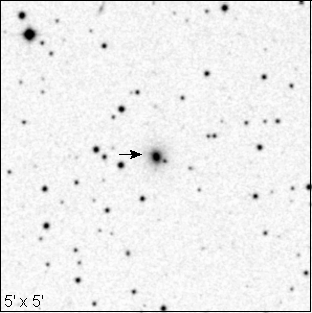 |
(2000.0) (1950.0) Magnitude Size Type z Distance Mmax t Discoverer Nature Veron Hewitt-Burbidge |
17 22 33.1 +24 45 00 (RS) 17 20 27 +24 48 00 (GCVS) 16.1 - 17.7 20" x 16", 15° E 0.0637 246 Mpc -21.0 0.8 Bill. years Hoffmeister 1958 Bond 1972 (identity), Bond, Tifft 1974 (z) - - |
The object was discovered in 1958 by Cuno Hoffmeister
at Sonneberg [1], together with V396 Her. It was designated Sonneberg variable
5246. Hoffmeister found irregular brightness variations between 16.1 and 17.7,
in one case the object faded by 0.7 mag in 48 minutes! He mentioned, that the
object is well separated from a 17.5 mag star 20" SE.
In 1972 Bond [2], using Hoffmeister's finding chart, noticed the nonstellar appearence on the POSS, suggesting a compact or N-galaxy. The object is contained in Zwicky's 8th list of compact galaxies [4], published after his early death in 1974. As he refers Bond's paper, he might found the „red variable compact" around 1972 on the POSS. Bond and Tifft [3] later determined a redshift of z=0.0637. Due to the normal appearence of the spectrum and the extended image they questioned the reality of the light variations reported by Hoffmeister. The modern redshift-value was measured by Osterbruck and Grandi [5]. The object is not known to be a radio or Xray source.
References
[1] Hoffmeister, C., AN 284, 275 (1958); Veröff. Sternw. Sonneberg 4, 319 (1960)
[2] Bond, H.E., ApJ 174, L163 (1972)
[3] Bond, H.E., Tifft, W.G., PASP 86, 981 (1974)
[4] Zwicky, F., Sargent, W.L.W., Kowal, C.T., AJ 80, 545 (1975)
[5] Osterbrock, D.E., Grandi, S.A., ApJ 228, L59 (1979)
|
V396 Her S5289 = 1E 1720+246 = 87GB 172040.9+243904 |
QSO in Hercules | |
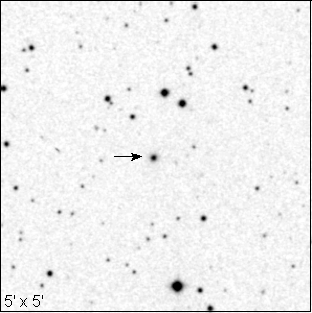 |
(2000.0) (1950.0) Magnitude Size Type z Distance Mmax t Discoverer Nature Veron Hewitt-Burbidge |
17 22 41.2 +24 36 18 (RS) 17 20 28 +24 39 06 (GCVS) 15.7 - 16.7 8" Sy1 0.175 642 Mpc -23.7 1.9 Bill. years Hoffmeister 1959 Bond 1977 (identity, z) V 396 Her (QSO) 1720+246 |
The object was discovered in 1958 by Cuno Hoffmeister at Sonneberg [1], together with V395 Her. It was designated Sonneberg variable 5289. Hoffmeister found brightness variations between 15.7 and 16.7, stating, that the object shows long stillstands between brief periods of of activity. Meinunger [2] suggested, that this „not red" star is a RR Lyrae variable with a period around 0.5 days.
In 1977 Bond et al. [3], searching for extragalactic objects in the GCVS with spectrographic methods, found V396 Her (togehter with GQ Com) to be a quasar at z=0.175. He noted, that the object looks stellar and slightly blue on the POSS. Xrays were discovered in 1979 with the Einstein satellite [4]. Blumenthal et al. [5] studied the optical and Xray properties of V396 Her and classified it as a Seyfert 1 galaxy. In 1987 the object was detected as a radio source with the Green Bank telescope (87GB).
References
[1] Hoffmeister, C., AN 284, 275 (1958); Veröff. Sternw. Sonneberg 4, 319 (1960)
[2] Meinunger, L., MVS 6, 133 (1974)
[3] Bond, H.E., Kron, R.G., Spinrad, H., ApJ 213, 1 (1977)
[4] Tananbaum, H., et al., ApJ 234, L9 (1979)
[5] Blumenthal, G.R., et al., ApJ 257, 499 (1982)
|
V1102 Cyg S9667 = PGC 62859 |
AGN in Cygnus | |
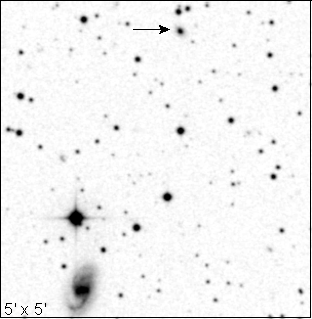 |
(2000.0) (1950.0) Magnitude Size Type z Distance Mmax t Discoverer Nature Veron Hewitt-Burbidge |
19 10 37.2 +52 13 13 (RS) 19 09 27 +52 08 00 (GCVS) 15.5 - 17. 18" x 10", 35° AGN 0.0272 106 Mpc -19.8 0.3 Bill. years Hoffmeister 1966 Bond 1973 (identity), Osterbruck, Grandi (z) - - |
The object was discovered in 1966 by Herta Gessner and Cuno Hoffmeister at Sonneberg [1], [2]. It was designated Sonneberg variable 9667. Hoffmeister [3] describes the object to remain usually at 17. mag with occasional brightenings to magnitude 15.5 that last several days. A light curve was presented by Gessner [6] in 1988.
In 1973 Bond [4] searched for extragalactic objects in the GCVS and found two cases: V1102 Cyg and X Com. He describes the POSS image of V1102 Cyg, that it „lies 5' NNW of an anonymous 14th mag spiral galaxy, and shows a slightly elongated core with a faint outer envelope". The anonymous galaxy is actually MCG 9-31-25 = UGC 11412 (14.6, Sb), which was already known in 1973. Bond suggested, that V1102 Cyg is an N-galaxy, pretty much like X Com. The redshift of z=0.0272 was determined by Osterbruck and Grandi [5] in 1979. V1102 Cyg is not known to be a Xray or radio source.
References
[1] Gessner, H., MVS 3, 171 (1966)
[2] Hoffmeister, C., MVS 3, 172 (1966)
[3] Hoffmeister, C., AN 289, 205 (1967)
[4] Bond, H.E., ApJ 181, L23 (1973)
[5] Osterbrock, D.E., Grandi, S.A., ApJ 228, L59 (1979)
[6] Gessner, H., MVS 11, 108 (1988)
|
V362 Vul E 2000+223 |
Galaxy in Vulpecula | |
 |
(2000.0) (1950.0) Magnitude Size Type z Distance Mmax t Discoverer Nature Veron Hewitt-Burbidge |
20 02 48.6 +22 28 27 (RS) 20 00 37 +22 00 00 (GCVS) 16.0 - 17.7 18" x 12", 120° AGN 0.029 131 Mpc -19.4 0.4 Bill. years Takalo, Nousek 1985 Shara et al. 1990 (galaxy) - - |
The object was discovered in 1985 by Takalo and Nousek [1] on the POSS, searching for the optical counterpart of the Einstein Xray source E 2000+223, detected in 1980. Based on the object's diffuse image, the low galactic latitude, the optical spectrum and VLA radio measurements they concluded, that it is an old nova shell. It was included in the GCVS as V362 Vul. Andronov [2] reports, that the object remains usually around 17.4-17.7, but outbursts (reaching 16. mag) are pesent on several plates taken around 1942 and 1965. He could not rule out, that a star 10" SE was responsible.
1990 Shara et al. [3], analysing old novae candidates, took a spectrum with the 3.6m CFHT, which shows a significant redshift of z=0.029. They concluded, that the object is actually a starburst galaxy (not mentioning the identity V362 Vul). The object is not known as a radio source.
References
[1] Takalo, L.O., Nousek, J.A., PASP 97, 570 (1985)
[2] Andronov, I.L., MVS 11, 84 (1988)
[3] Shara, M.M., et al., AJ 100, 540 (1990)
|
BL Lac VRO 42.22.01 = OY+401 = 1ES 2200+420 = IRAS 22006+4202 |
BL Lac/QSO in Lacerta | |
 |
(2000.0) (1950.0) Magnitude Size Type z Distance Mmax t Discoverer Nature Veron Hewitt-Burbidge |
22 02 33.3 +42 16 39 (RS) 22 00 39 +42 02 06 (GCVS) 12.4 - 17.2 30" x 15", 30° QSO/BL Lac 0.0686 269 Mpc -24.9 0.8 Bill. years Hoffmeister 1929 Schmitt 1968 (identity), Oke, Gunn 1974 (z) BL LAC (BL Lac) 2200+420 |
Cuno Hoffmeister discovered the object in 1929 at Sonneberg [1], naming it BL Lac. It lies in a crowded region of the Milky Way, rich on variable stars (BL was the 90th variable found in Lacerta). Hoffmeister reported irregular variability with short outbursts and brigthness changes of a factor 15 over several months. Shen and Usher [6] noticed a variable brightness between 12.5 and 16.5 from 1900 - 1970. A light curve was also presented by Pollock et al. [12]. In 1965 the object was detected as radio source VRO 42.22.01 at the Vermilion River Observatory by MacLeod et al. [2]. MacLeod and Andrew [3] noticed in 1968, that it shows a highly unusual flat radio spectrum. Using a more precise radio position, Arp was able to identify the source with a 14. mag stellar object on a plate taken with the 200" at Mt. Palomar (also published in [3]). It shows a faint galaxy-like halo around a compact core and Arp suggested it to be extragalactic. Taking into account its apparent brightness and an extinction of one magnitude at the low galactic latitude, MacLeod and Andrew stated, that the intrinsic luminositiy must be very high, typical for quasars. Prenston and Prenston [8] reported, that the sky background is partially covered by with a low surface brightness nebulosity, also mentioning a fuzzy low surface-brightness object 1' south of BL Lac, perhaps a galaxy (marked by the bars).
In early 1968 John Schmitt [4] found BL Lac to coincide with the radio source VRO 42.22.01. Visual inspection in moderately good seeing at the Cassegrain focus of the 5m Palomar telecsope shows a diameter less than 2". Spectrosopic observations of DuPuy et al. [5] led to the result, that the spectrum is continuous with no emission lines, which is unusual for quasar-like objects. BL Lac was too red for a QSO and to blue for an N-galaxy („the true nature of this remarkable object remains a mystery"). The redshift was first determined in 1974 by Oke and Gunn [9], getting z=0.07 from absorption lines, which shows the extragalactic nature (confirmed later by Miller et al. [11]). According to Strittmatter et al. [11], BL Lac is the protptype of an independent class ar quasar-like objects (see also [10]), jokingly termed „blazar" by Ed Spiegel. Unfortunately Vermeulen et al. [12] found evidence, that BL Lac behaves occasionally like a normal quasar, showing typical emission lines. Xray emission was detected in 1979 with the Einstein satellite and it appears as an infrared source in the IRAS catalogue.
References
[1] Hoffmeister, C., AN 236, 233 (1929)
[2] MacLeod, J.M., et al., AJ 70, 756 (1965)
[3] MacLeod, J.M., Andrew, B.H., Ap. Letters 1, 243 (1968)
[4] Schmitt, J.L., Nature 218, 663 (1968)
[5] DuPuy, D., et al., ApJ 156, L135 (1969)
[6] Shen, B.S.P., Usher, P.D., Nature 228, 1070 (1970)
[7] Strittmatter, P.A., et al., ApJ 175, L7 (1972)
[8] Prenston, M.V., Prenston, M.J., MNRAS 162, 109 (1973)
[9] Oke, J.B., Gunn, J.E., ApJ 189, L5 (1974)
[10] Disney, M.J., Veron, P., Scientific American, August 1977, p. 32
[11] Miller, J.S., at al., ApJ 219, L85 (1978)
[12] Pollock, J.T., et al., AJ 84, 1658 (1979)
[13] Vermeulen, R.C., at al., ApJ 452, L5 (1995)